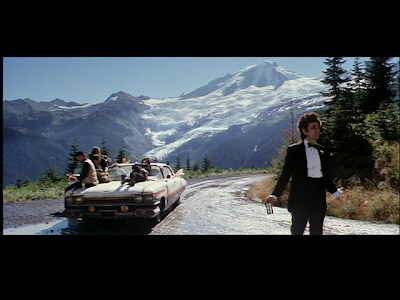In director Jake Kasdan's movie Orange County(2002) the story takes place in Southern California in character Shaun Brumder’s (Colin Hanks) senior year of high school. He wants to become a professional surfer until one day he finds a book in the sand which makes him want to be a writer. The author of this book is a professor at Stanford and this makes Shaun aspire to go there to become a writer. The problem is though, that the college counselor mixes his application with another kid and he gets stuck in Orange County. This sets Shaun on an adventure to find a way into Stanford.
At 13 minutes and 34 seconds, Shaun is running away from the college counselor’s office right after he finds out that his transcript was mixed up. He thinks his life is ruined because now he can’t become a writer. He believes the only way to become a successful writer is to get into Stanford where his idol is a professor at.
This shot shows how Shaun is “trapped” in Orange County. Others around him encourage him to just go to the community college in the area like everyone else does, but Shaun doesn’t want to be “everyone else”. If he can’t go to Stanford he feels like there’s no way for him to get out of Orange County.
It was a good choice by the director to choose this narrow passage for this part in the movie. With the walls presence dominating over Shaun, it depicts how he’s trapped in Orange County with the rest of the kids there. With the walls being so tall it signifies how there is no way out, at least that’s what Shaun thinks. The long corridor makes it seem like Shaun’s been running forever or is running away from Orange County.
This long shot of Shaun running depicts how far away he is from what he wants to do in life. It also shows how small Shaun is to the world around him along with the walls of the corridor towering over him. As Shaun runs towards the camera it represents that by the end of the movie he’ll overcome his problem and get closer to the world around him. The director uses a wide angle lens to make Shaun seem smaller and to make the walls seem way bigger than him. Shaun is far away so it makes it so he has less power since he just got rejected from college.
When I was picking which shot to use for this I was assuming I would pick a shot with a lot going on. Then I saw this shot and it shocked me how much was in it. It’s a pretty plain shot and to the naked eye there isn’t much going, but because of the circumstances in the movie it makes perfect sense. It’s the perfect shot for a kid trying to escape his current situation.
Alright honestly, does anyone see this shot in the way I do? Or am I just blowing it out of proportion?
Mr. Cowlin here. Ben's last question got me thinking...How do we know when we've blown things out of proportion? How much is 'too much' when it comes to analyzing movies? Any ideas?


















